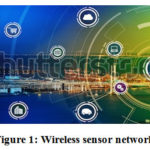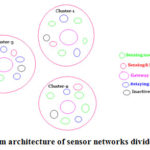Suneela Kallakunta* and Alluri Sreenivas
Department of ECE, GITAM (Deemed to be University), Visakhapatnam, India.
Corresponding Author E-mail id: suneelakallakunta@gmail.com
DOI : http://dx.doi.org/10.13005/ojcst13.0203.10
Article Publishing History
Article Received on : 28 May 2020
Article Accepted on : 29 Jun 2020
Article Published : 30 Dec 2020
Plagiarism Check: Yes
Article Metrics
ABSTRACT:
Wireless sensor networks (WSNs) are a new kind of wireless networks that are becoming very popular with a large number of civilian and military applications. A wireless sensor network (WSN) is a wireless network that contains distributed independent sensor devices that are meant to monitor physical or environmental conditions. AWireless Sensor Network consists of a set of connected tiny sensor nodes, which communicate with each other we can also interchange information and data. These nodes obtain information on the environment such as temperature, pressure, or humidity and this information is stored in a base station. The latter sends the info to a wired network or activates an alarm or an action, depending on the type of data being monitored.
KEYWORDS:
Wireless Sensor Networks
Copy the following to cite this article:
Kallakunta S, Sreenivas A. Technical Aspects of Wireless Sensor Networks (WSNs). Orient.J. Comp. Sci. and Technol; 13(2,3).
|
Copy the following to cite this URL:
Kallakunta S, Sreenivas A. Technical Aspects of Wireless Sensor Networks (WSNs). Orient.J. Comp. Sci. and Technol; 13(2,3). Available from: https://bit.ly/3hmDoY3
|
Introduction
Wireless Sensor Networks (WSNs) as the name suggests are a class of networks where the nodes are sensor nodes. The nodes which have the capability of sensing the physical phenomena that occur around them. These sensing can be of different types , a particular sensor node might be able to sense temperature, might be able to sense pressure, they can sense if there is any object that is moving around them. Sensors can also sense colors, can sense vibrations occurring around, can sense whether there is any sound around the sensors and so on.
Internet of Things (IoT)
Internet of Things (IoT) and Wireless Sensor Networks (WSNs) are very important components of building smart cities which have become very popular since the last few years.
Wireless
Sensor Networks (WSNs)
Wireless Sensor
Networks (WSNs) basically consists of the following:
It consists of a collection of different sensor nodes and these sensor nodes are not necessarily, but typically they are densely deployed in an area. So the sensor nodes they basically communicate with one another, the sensor nodes first of all they have the capability of sensing the physical phenomena that are occurring around them.
For example like if there is a light sensor which is in the sensor node then the sensors can sense light. Similarly temperature, sound, vibration and so on.
Like the above there are other types of sensing that can happen and the different types of sensors that can be embedded in a sensor node. The sensor nodes, they can collaborate with one another and collectively the sensed data that are obtained from these using the sensor nodes they are transformed into digital signals to process the physical phenomena that are occurring around the sensors.
Due to the fact that the sensor node in Wireless Sensor Network (WSN) have short radio transmission range, intermediate nodes act as relay nodes to transmit data towards the sink data using a multi – hop path.
The sensed data from one node through a multi – hop path, they are sent to the remote destination node. This remote destination node is termed in the sensor network as Sink node.
A base station may or may not be a sensor node whereas a Sink node necessarily is a Sensor node. So essentially if there is a Computer or some kind of data collecting device which is connected to a Sink node then all the data that are received at the Sink node they could be stored in that particular computing device.
Use
of these Sensor Networks
The distinction between the stand – alone or individual sensors and the sensor networks is that where as an individual sensor can sense the phenomena locally in a stand – alone fashion.
In a sensor network, you can deploy multiple such sensors and sensor nodes over a larger area in order to get an idea about what is occurring that larger area. So basically to have bigger sensing coverage over a bigger area this is why the Sensor networks become useful. If somebody wants to remotely monitor a particular area, so sensor network become very useful, they come out to be very handy remotely in an unmanned fashion monitoring a particular region.
Classification of Sensor Networks
Sensor
networks are broadly classified into 2 types:
Stationary Sensor Network
Mobile Sensor Network
Stationary Sensor Network
It means that all the nodes in the sensor network are stationary i.e.none of the nodes in the network moves.
Mobile Sensor Network
It is essential that some or in the extreme case all the nodes in the network would move. There are multiple applications of Mobile Sensor Networks.
Mobile Sensor Networks are found in oceans, so when we deploy sensor nodes on a ocean the nodes will be mobile due to the fact that there are ocean waves and currents. Such a network is going to be a Mobile Sensor Network. In terrestrial environments also sensors fitted to the different trucks and buses and cycles and so on, which basically move on the road, because of the mobility of these vehicles the nodes they move and that is why we have a Mobile Sensor Network.
Basic Components of a Sensor Node
Application – Dependent Units (Ex : Location Finding System, Mobilizer Unit)
A typical sensor node, a sort of like mini – computing device, which has additional capabilities of sensing. A typical sensor node has a Sensing Unit, it has a component which is a sensor which can sense certain physical phenomena according to the way they have been designed.
Processing Unit, means a Processor, so we have the Sensing Unit, we have a Processing Unit then there is a Transceiver Unit for communication purposes.
A Power Unit for powering up the node, typically different types of batteries are used, Lithium – Ion batteries are used.
Then, there are other application dependent units that can also be there in addition to these 4 units.
As you can see whatever
you find in a mini – computer.
A Computer is nothing but where there is a processing capability, so a processor is there in the Computer and in a Sensor node as well plus communication capabilities are available as well.
Sensor nodes are originally small in size and they come in diverse shapes, so that the sensor nodes are typically comparable to the size of a finger tip, to the size of coins and they are much smaller compared to the size of a palm.
Shape of a sensor nodes come in different shapes circular, spherical, and they could come in different other shapes i.e., rectangular, square and so on.
Sensor nodes, they are multi functional, so depending on the type of sensor that is installed / embedded in these nodes they can sense different things.
They have very short transmission ranges because of the limitation of the transceiver unit. Because of the size of the nodes again the capabilities of each of these components are also very limited.
So, the sensor nodes like a Computer, they have an Operating System (Tiny Operating System is a very popular Operating System that is used in sensor nodes).
Sensor nodes are battery operated, they are battery powered, they have very limited life. Not only that they are battery powered but the batteries that are used in small size. So, consequently the batteries also have very limited life time, because of its limited life time what is very important is to ensure that whatever solution Hardware, Software or whatever it is that is designed specifically for the sensor networks, the solutions should be very much energy efficient. Algorithms has to be designed, the protocols that you design, the Hardware that you design, should be designed in such a way that energy consumption is very limited.
Constraints on the Sensor nodes
Small size, typically
less than a cubic centimeter.
Must consume extremely
low power.
Operate in an
unattended manner in a highly dense area.
Should have low
production cost and be dispensable.
Be autonomous. They should not be any human intervention, human beings convey and doing things.
Be adaptive to the environment in which they operate. So, if there is any change in the environment the node should be able to strategize itself accordingly.
Conclusion
The distinction between the stand – alone or individual sensors and the sensor networks is that where as an individual sensor can sense the phenomena locally in a stand – alone fashion. So basically to have bigger sensing coverage over a bigger area this is why the Sensor networks become useful.
If somebody wants to remotely monitor a particular area, so sensor network become very useful, they come out to be very handy remotely in an unmanned fashion monitoring a particular region.
References
- S. Dhurandher, S. Misra, M. S. Obaidat
and S. Khairwal, “UWSim: a simulator for underwater wireless sensor networks,”
Simulation: Transactions of the Society for Modeling and Simulation
International, SCS, Vol. 84, No. 7, pp. 327–338, July 2008.
- S. Misra, K. Abraham, M. S. Obaidat and
P. Krishna, “LAID: a learning automata based scheme for intrusion detection in
wireless sensor networks,” Security and Communications Networks, Wiley, Vol. 2,
No. 2, pp. 105–115, March/April 2009.
- M. S. Obaidat, P. Nicopolitidis and
J.-S. Li, “Security in wireless sensor networks,” Security and Communications
Networks, Wiley, Vol. 2, No. 2, pp. 101–103, March/April 2009
- S. Misra, M. S. Obaidat, S. Sanchita and
D. Mohanta, “An energy-efficient, and secured routing protocol for wireless
sensor networks,” in Proceedings of the 2009 SCS/IEEE International Symposium
on Performance Evaluation of Computer and Telecommunication Systems, SPECTS
2009, pp. 185–192, Istanbul, Turkey, July 2009.
- S. Misra, K. I. Abraham, M. S. Obaidat and
P. V. Krishna, “Intrusion detection in wireless sensor networks: the S-model
learning automata approach,” in Proceedings of the 4th IEEE International
Conference on Wireless and Mobile Computing, Networking and Communications: The
First International Workshop in Wireless and Mobile Computing, Networking and
Communications (IEEE SecPriWiMob’08), pp. 603–607, Avignon, France, October
12–14, 2008
- S. K. Dhurandher, S. Misra, M. S.
Obaidat and N. Gupta, “QDV: a quality-based distance vector routing for wireless
sensor networks using ant colony optimization,” in Proceedings of the 4th IEEE
International Conference on Wireless and Mobile Computing, Networking and
Communications: The First International Workshop in Wireless and Mobile
Computing, Networking and Communications (IEEE SecPriWiMob’08), pp. 598–602,
Avignon, France, October 12–14, 2008.
- S. Misra, V. Tiwari and M. S. Obaidat,
“Adaptive learning solution for congestion avoidance in wireless sensor
networks,” in Proceedings of the IEEE/ACS International Conference on Computer
Systems and Applications, AICCSA 2009, pp. 478–484, Rabat, Morocco, May 2009
- “History
of Innovation,” 1995-2012. [Online]. Available:
http://www.ti.com/corp/docs/company/history/sensortimelinelowbandwidth.shtml.
[Accessed 6 january 2012].
- I.
F. Akyildiz, T. Melodia and K. Chowdury, “A survey on wireless multimedia
sensor networks,” Computer Networks, vol. 51, no. 4, pp. 921-960, 2007.
- C.-Y. Chong and S. P. Kumar, “Sensor networks:
evolution, opportunities, and challenges,” Proceedings of IEEE, Vol. 91, No. 8,
pp. 1247–1256, 2006.
- R. MacRuairi, M. T. Keane and G.
Coleman, “A wireless sensor network application requirements taxonomy,” in 2008
IEEE International Conference on Sensor Technologies and Applications, IEEE
Computer Society, pp. 209–216, 2008
- P. Nicopolitidis, M. S. Obaidat, G. I.
Papadimitriou and A. S. Pomportsis, Wireless Networks, John Wiley & Sons,
2003.
- K. Sohraby, D. Minoli and T. Znati,
Wireless Sensor Networks: Technology, Protocols, and Applications, John Wiley
& Sons, 2007.
- W. Dargie and C. Poellabauer,
Fundamentals of Wireless Sensor Networks: Theory and Practice, John Wiley &
Sons, 2010
- www.shutterstock.com

This work is licensed under a Creative Commons Attribution 4.0 International License.



